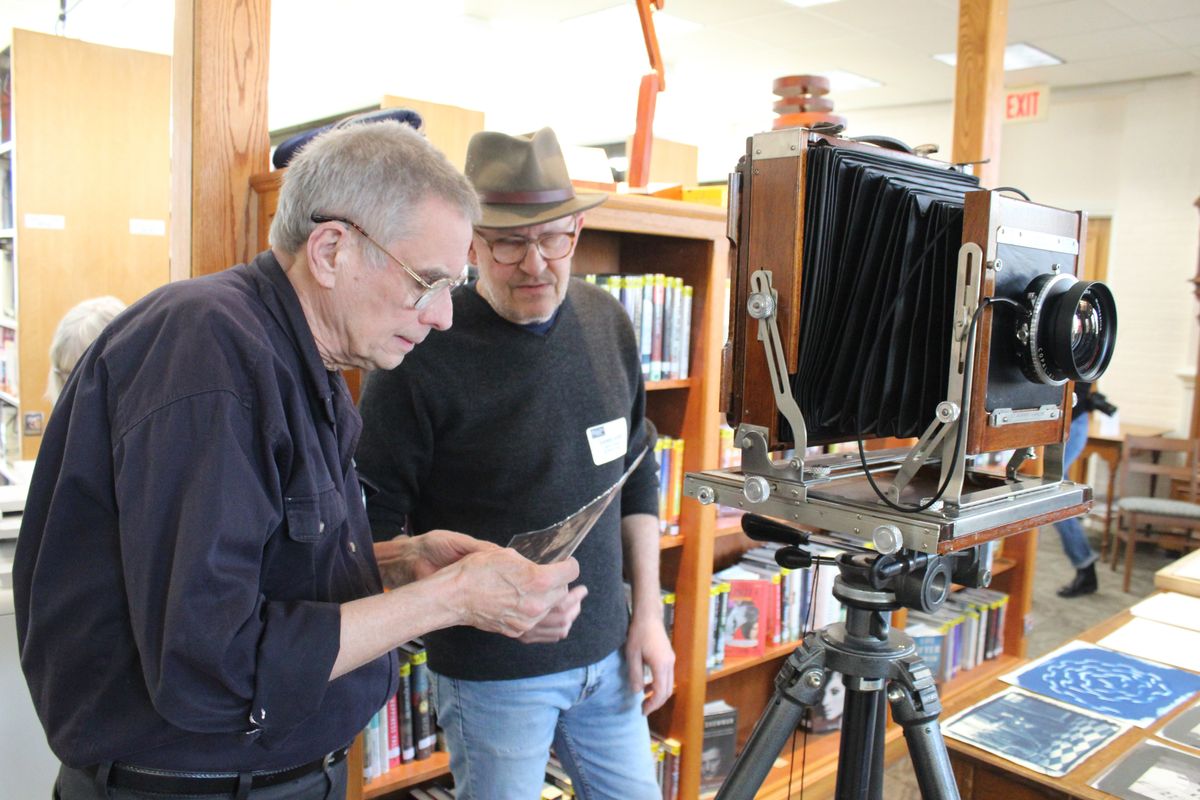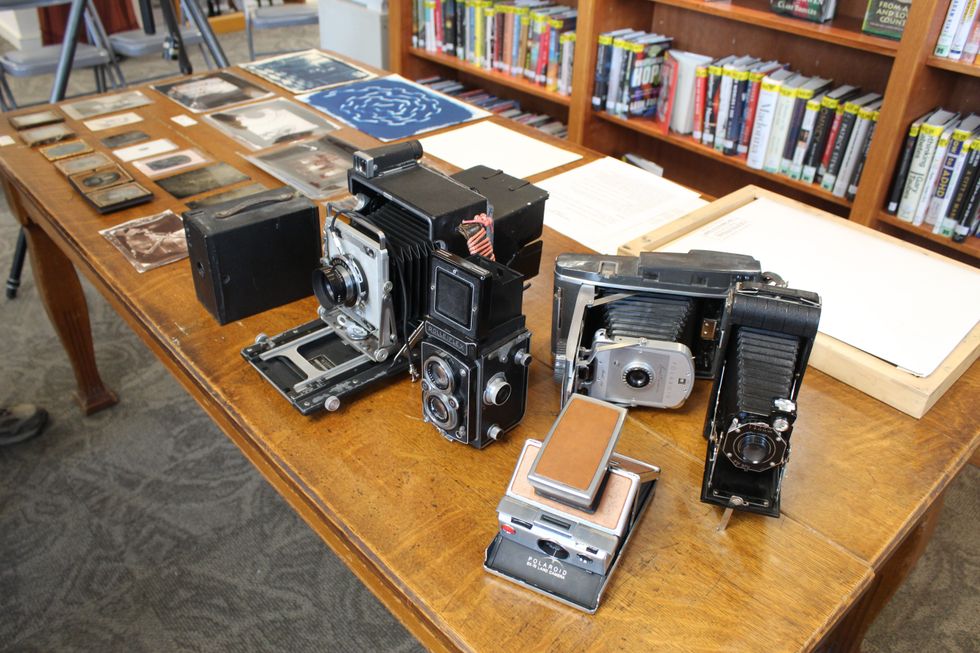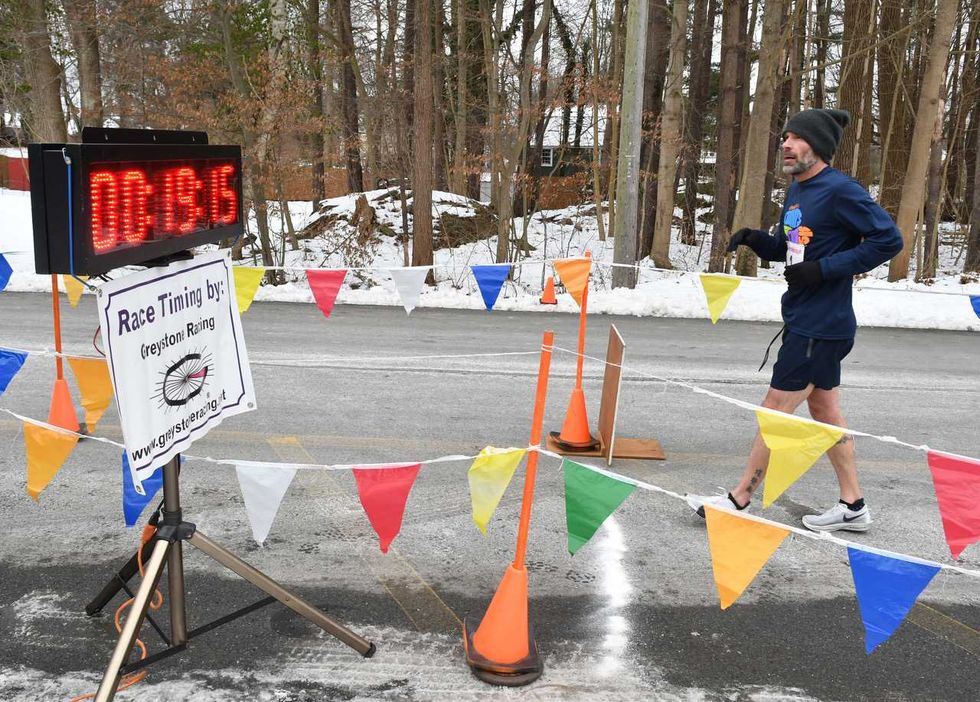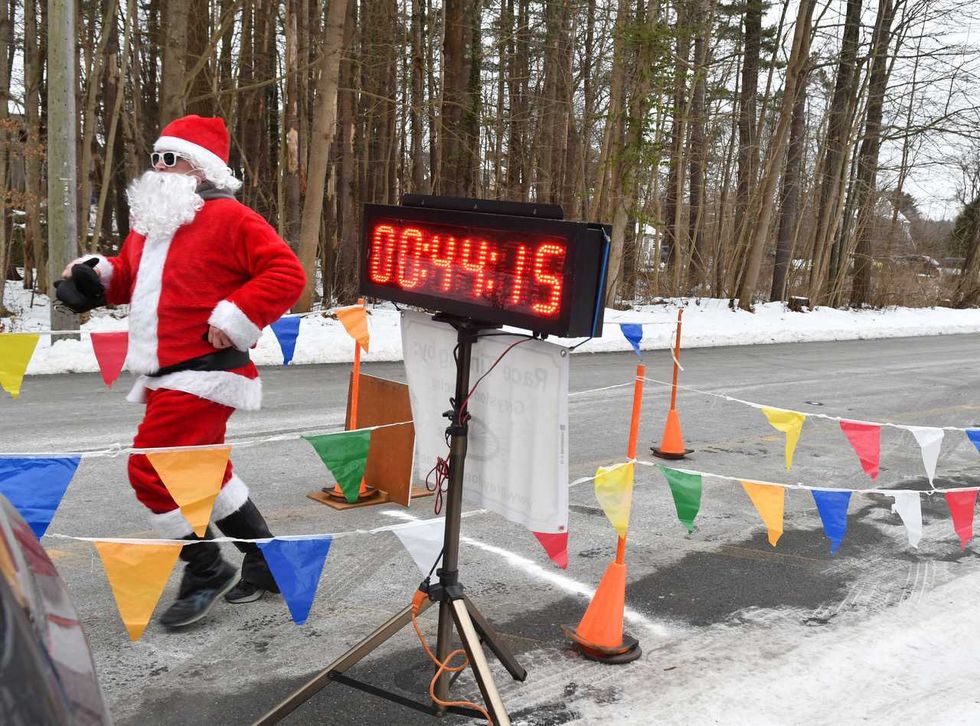Tracing the transformative path of photography at Hunt Library

Sergei Fedorjaczenko (left) conferred with Daniel Karp.
Patrick L. Sullivan

Sergei Fedorjaczenko (left) conferred with Daniel Karp.
FALLS VILLAGE — Daniel Karp delivered an overview of the changes in photography prior to the reception for “From the Great Falls to the Hilltops: Early 20th Century Photography from the Falls Village-Canaan Historical Society” at the David M. Hunt Library Saturday, March 16.
Karp, who teaches photography at Bard College at Simon’s Rock in Great Barrington, Massachusetts, had an array of cameras and daguerreotypes, tintypes and other contraptions and ephemera with him.
“This is show and tell,” he said to the audience of some 35 people.
To begin, he produced a split back contact printing frame and inserted an 8- by 10-inch negative taken with the massive Deardorff view camera he had on an equally substantial tripod.
He then added a piece of photographic paper that is light sensitive but won’t get ruined immediately by exposure to sunlight, and is long out of production.
“Do you have a stash?” asked someone.
“I used to work for the company, so yes, I do,” Karp replied, fitting the arrangement together and taking it over and propping it up on a windowsill with good exposure.
After a brief tour through the origins of photography, starting in China circa the fifth century B.C.E. with the camera obscura, he came to the 19th century C.E. and two processes that emerged in 1839 and 1840, respectively: Louis Daguerre’s daguerreotype, and William Henry Fox Talbot’s salt print.
Staying out of the technical weeds, the bottom line was this: the daguerreotype produced a unique image, “a one-off,” while Talbot’s invention made it possible to make “endless copies.”
The 1850s saw the invention of light-sensitive emulsions that could be put on glass slides or metal — the “tintype.” While still cumbersome by later standards, the technology was getting easier to use.
The big breakthrough was when Kodak introduced flex film in 1889, and the Brownie camera in 1900.
Karp said, now that photography was available to a mass market, people no longer needed to hire a professional photographer and sit for a portrait. They could create their own candid images.
Karp said the reason people look so serious in old studio photographs is two-fold: The slow shutter speeds required to get a usable image meant the subject had to sit very still, and for most people, the studio portrait would be the only image they ever sat for in their lives. Karp said studio photographers used a variety of devices such as head clamps to keep the objects still, and family portraits often have the adults in good focus, but the fidgety children are blurry.

Cameras and materials continued to get smaller and easier to use. Karp showed the crowd the type of bellows camera that took a 4- by 5-inch negative beloved of press photographers in the early to mid-20th century, a Rolleiflex twin-lens reflex camera that took a 2 ¼ inch square negative, and a couple of Polaroids, which delivered almost instant results.
Karp said today “billions of photographs are taken digitally — but where are they?”
Photos tend to be stored on devices, in the cloud, on external storage devices — but not in photo albums, with the negatives carefully tucked away in case someone wanted an extra print.
Karp finished up by fetching the contact print frame from the window. With a conjurer’s flourish, he revealed a perfectly decent image from the 8 by 10 negative and special paper.
He quoted author Arthur C. Clarke: “Any sufficiently advanced technology is indistinguishable from magic.”
Karp stuck around to answer questions as the reception for the historical photos kicked off with refreshments and music appropriate to the early 20th century.
On Saturday, March 23, at 3:30 p.m. at the library, Michele Majer will lead a fashion talk on early 20th century fashion as seen in the exhibition’s photographs. The main exhibit will be on display through May 3.
Runners line up at the starting line alongside Santa before the start of the 5th Annual North Canaan Santa Chase 5K on Saturday, Dec. 13.
NORTH CANAAN — Forty-eight runners braved frigid temperatures to participate in the 5th Annual North Canaan Santa Chase 5K Road Race on Saturday, Dec. 13.
Michael Mills, 45, of Goshen, led the pack with a time of 19 minutes, 15-seconds, averaging a 6:12-per-mile pace. Mills won the race for the third time and said he stays in shape by running with his daughter, a freshman at Lakeview High School in Litchfield.

Don Green, 64, of Red Hook, New York, was second among male runners with a time of 21:17 and a 6:52-per-mile pace. Becky Wilkinson, 47, of Southfield, Massachusetts, was the first woman to cross the finish line with a time of 22:16, averaging a 7:11-per-mile pace. Wilkinson finished fourth overall.
Margaret Banker, 52, of Lakeville, finished second among women runners with a time of 23:59 and a 7:44-per-mile pace.
Runners came from all over Connecticut, Massachusetts and New York. One runner listed home as London, England. Many were members of the Run 169 Towns Society, a group that is dedicated to completing races in every one of Connecticut’s 169 towns. Elizabeth Smith, 32, of Manchester, a member of Run 169, said this was her 162nd town.
“I started 10 years ago,” Smith said. Her husband, Daniel, 33, has run races in 73 Connecticut towns, now including North Canaan. He was eager to know where to get a good cup of coffee after the race.
Santa, who got a head start on the group of runners but finished next to last with a time of 44:14, has been a feature in the North Canaan race since it started five years ago.
The 5K proceeds from a start in front of the North Canaan Elementary School on Pease Street to course around the Town Hall parking lot, up West Main Street past the transfer station to the state line and back. Cheryl Ambrosi, 45, of Danbury, was the last to cross the finish line with her dog Benji. “It was so much fun,” she said as she ended, even though she didn’t catch Santa.

The Torrington Transfer Station, where the Northwest Resource Recovery Authority plans to expand operations using a $350,000 state grant.
TORRINGTON — The Northwest Resource Recovery Authority, a public entity formed this year to preserve municipal control over trash and recycling services in northwest Connecticut, has been awarded $350,000 in grant funds to develop and expand its operations.
The funding comes from the Department of Energy and Environmental Protection via its Sustainable Materials Management grant program. It is intended to help the NRRA establish operations at the Torrington Transfer Station as well as support regional education, transportation, hauler registration and partnerships with other authorities.
Founded by the City of Torrington in May 2025, the NRRA was established to oversee regional municipal solid waste management. Its creation followed a $3.25 million offer by USA Waste & Recycling to purchase the Torrington Transfer Station — a sale that would have privatized trash services in the region.
The proposed sale was initially approved by the MIRA Dissolution Authority, the entity responsible for dissolving the state’s former Materials Innovation and Recycling Authority, which owned the Transfer Station at the time. Before the transaction could close, the state intervened and directed that the facility’s operating permit be assigned to the NRRA to preserve a publicly controlled alternative.
MIRA has since dissolved, and the Transfer Station is currently operated by the state Department of Administrative Services. Many towns in northwest Connecticut have expressed interest in joining the NRRA. As of December, Torrington and Goshen were the only two municipalities in the authority.
At the Dec. 11 meeting of the Northwest Hills Council of Governments (COG) — a regional planning body representing 21 municipalities in northwest Connecticut — Director of Community and Economic Development Rista Malanca encouraged more towns to sign on.
“We need towns to join the Northwest Resource Recovery Authority to show your support, show this is what you want to do,” Malanca said.
Salisbury First Selectman Curtis Rand said his municipality is planning a town meeting in January to vote on a resolution to join the NRRA. Cornwall’s Board of Selectmen recently discussed scheduling a town meeting in the winter for the same purpose. Sharon, Falls Village and North Canaan have also expressed continued interest in pursuing a public option.
Kent is the northernmost member of the Housatonic Resource Recovery Authority, a regional solid waste authority representing 14 municipalities stretching south to Ridgefield. COG towns expressed interest in joining HRRA in 2024, but they were denied and set out to develop the NRRA.
“We also have been having conversations with the Capital Region Council of Governments and the Naugatuck Valley Council of Governments to think about how we can use existing resources, maybe some of these grant funds, to bring in shared resources or shared staffing that will help with some of the recycling coordinating efforts,” Malanca said.
With grant funds secured, NRRA aims to grow to a point that it can take over operations at Torrington Transfer Station to serve as a regional hauling hub. What happens to the trash after that has yet to be determined. Currently, it is being shipped to a landfill out of state. The existing municipal refuse hauling contracts that were established with the state expire in 2027.
The Salisbury Winter Sports Association (SWSA) will host its annual Junior Jump Camp, a two-day introduction to ski jumping, on Saturday and Sunday, Dec. 27 and 28, from 9 a.m. to 2 p.m. at Satre Hill in Salisbury.
The camp is open to children ages 7 and up and focuses on teaching the basics of ski jumping, with an emphasis on safety, balance and control, using SWSA’s smallest hill. No prior experience is required.
The cost is $50 per child and includes instruction and lunch on both days. For more information or to register, visit www.skireg.com/swsa-camp or email info@jumpfest.org
Jesse Bunce, first selectman of North Canaan.
LITCHFIELD — The Northwest Hills Council of Governments welcomed six newly elected municipal leaders Thursday, Dec. 11, at its first meeting following the 2025 municipal elections.
The council — a regional planning body representing 21 towns in northwest Connecticut — coordinates transportation, emergency planning, housing, economic development and other shared municipal services.
Barkhamsted First Selectman Meaghan Cook, Goshen First Selectman Seth Breakell, Kent First Selectman Eric Epstein, Norfolk First Selectman Henry Tirrell, North Canaan First Selectman Jesse Bunce and Torrington Mayor Molly Spino were each elected to their post in November.
They filled the seats of their predecessors on the COG, who were each given a toast of appreciation: Nick Lukiwsky (Barkhamsted), Todd Carusillo (Goshen), Marty Lindenmeyer (Kent), Matt Riiska (Norfolk), Brian Ohler (North Canaan) and Elinor Carbone (Torrington).
COG Executive Director Rob Phillips said the outgoing members were given a going away mug that read “You’re living the dream still.” Members voted to appoint Warren First Selectman Greg LaCava to fill a vacancy on the Council’s Executive Committee. COG members voted by paper ballot, and LaCava defeated Burlington First Selectman Doug Thompson for the vacant seat.